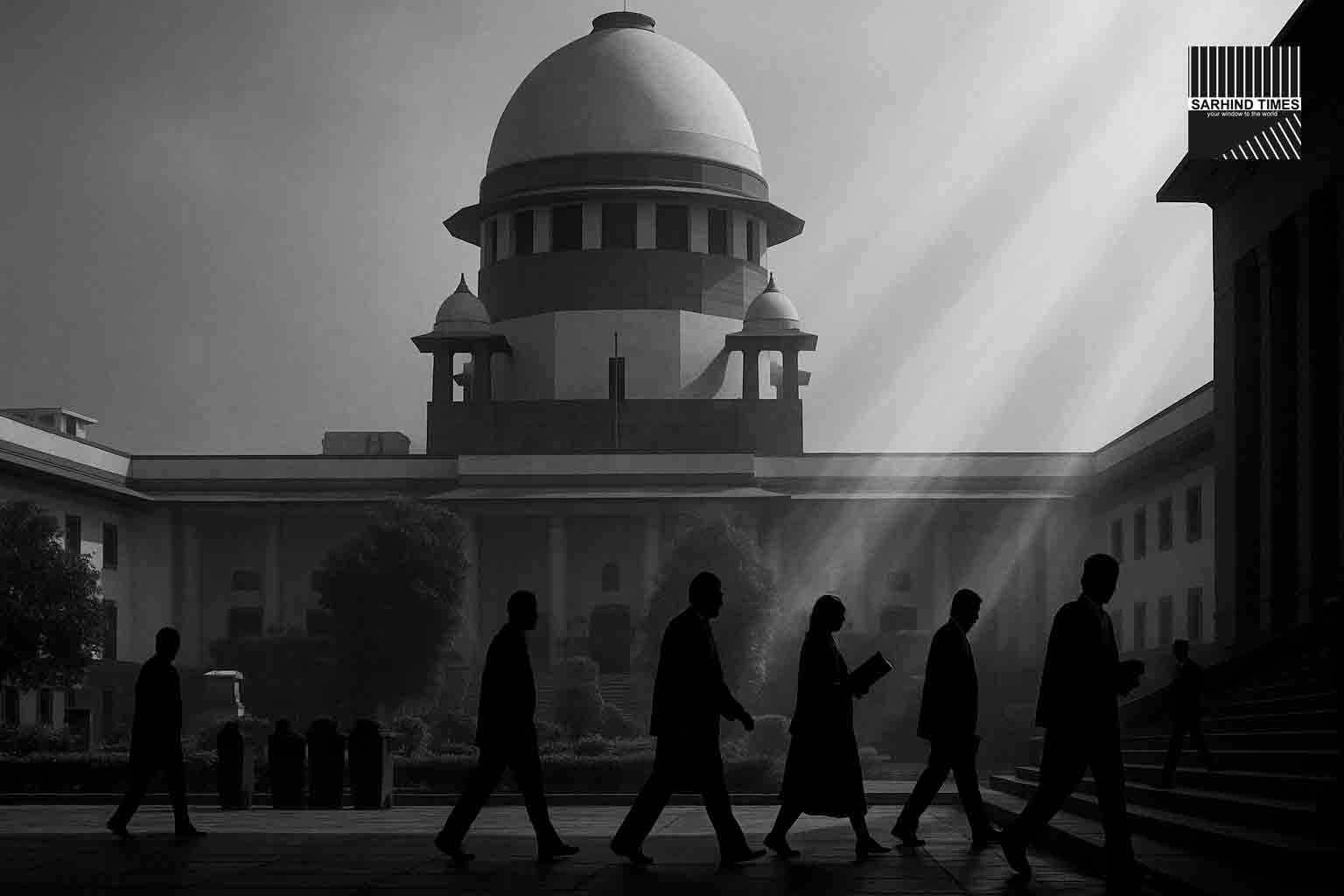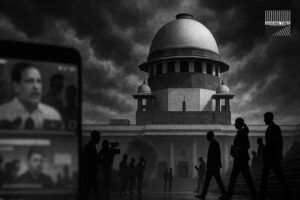By SarhindTimes Legal Affairs Desk | SarhindTimes.com
Date: October 8, 2025
In a move that could reshape the career architecture of India’s subordinate judiciary, the Supreme Court of India has referred a long-pending dispute over the promotion and seniority of judicial officers to a Constitution Bench.
The Court observed that fragmented rulings, differing state practices, and ad-hoc appointments have created prolonged uncertainty within the ranks of trial-court judges — affecting morale, recruitment, and ultimately, the speed and consistency of justice delivery.
1. The Context: Years of Confusion in Judicial Service Promotions
The dispute over how lower-court judges are promoted — whether by merit-cum-seniority, seniority-cum-merit, or competitive fast-track routes — has simmered for decades.
Across India’s 25 High Courts, service rules differ widely. Some states rely on seniority; others favor performance metrics or limited departmental examinations. As a result, district judges of similar experience in different states often reach higher posts at different times, creating inequity within a unified judicial system.
Past judgments, such as All India Judges’ Association (1992 and 2002), O.P. Singla v. Union of India, and Malik Mazhar Sultan v. U.P. PSC, attempted to streamline appointments but left gaps on promotion methodology and quota reconciliation. The absence of a definitive constitutional framework has caused litigation in multiple states, many of which are now clubbed before the Supreme Court.
2. The Court’s Observations
A Bench led by Justice Surya Kant, joined by Justices Abhay S. Oka and Manoj Mishra, noted that:
“Divergent rules and precedents have fragmented the service structure. Consistency demands an authoritative pronouncement by a larger Bench.”
The Court stressed that the judicial service is one integrated institution under Articles 233–236 of the Constitution, and its administrative framework must maintain uniform principles of fairness and merit.
The matter has therefore been placed before a five-judge Constitution Bench to interpret:
- How seniority should be determined between direct recruits and promotees.
- The permissible ratio between promotion, limited competitive examination, and direct recruitment.
- Whether “fast-track” or ad-hoc promotions can later be merged into the regular cadre without violating equality principles.
3. The Core Issues at Stake
a) Seniority Paradox
Two officers joining at the same level—one through direct recruitment, another through promotion—may find their career trajectories inverted within a few years due to inconsistent counting of “past service.”
For instance, some High Courts count years served in the lower cadre, while others fix seniority from the date of appointment as District Judge.
b) Quota Conundrum
Under Article 233(2), one-third of District Judge posts are reserved for direct recruits (typically lawyers of 7+ years’ standing), while the rest come through promotion. Yet, in practice, quota adherence and roster management vary state-to-state, leading to surplus promotees or vacant direct-recruit seats.
c) Merit vs Seniority Balance
A purely seniority-based system can stifle motivation; a purely merit-based one risks subjectivity. Striking the right equilibrium is central to the Constitution Bench’s mandate.
4. Impact on the Judicial System
Delays & Morale
Lower-court judges form the backbone of India’s judiciary, handling nearly 85 per cent of pending cases nationwide. Inconsistent promotion timelines have discouraged many officers, some waiting over 15 years for advancement.
Administrative Disarray
Different states maintain separate promotion panels, evaluation criteria, and “zone of consideration” rules. The absence of a uniform yardstick complicates inter-state transfers and All India Judges’ Association initiatives.
Recruitment Pipeline
Uncertainty over career progression has deterred bright law graduates from opting for the judicial service, preferring litigation or corporate practice instead.
Legal scholar Prof. Upendra Baxi recently observed that “clarity in career growth is essential if we want the judiciary to attract the best minds, not just the most patient ones.”
5. Reaction from Stakeholders
Judicial Officers’ Associations
Associations representing subordinate judges across Uttar Pradesh, Maharashtra, Tamil Nadu, and Gujarat welcomed the reference as “a long-awaited step toward certainty.”
They argue that conflicting promotions within the same service cadre have eroded trust and collegiality.
“This reference promises overdue clarity that can stabilize careers and, by extension, case disposal rates,” said an office-bearer of the All India Judicial Officers’ Association.
Legal Experts
Constitutional experts like Indira Jaising and Colin Gonsalves have hailed the move, noting that Articles 233–235 form a delicate bridge between executive control and judicial independence.
Standardizing service law will reduce state interference and reinforce institutional autonomy.
6. Historical Background: How We Got Here
The First National Judicial Pay Commission (Shetty Commission, 1999) had recommended a uniform three-tier system:
- Civil Judge (Junior Division)
- Civil Judge (Senior Division)
- District Judge
It also proposed structured benchmarks for promotion, training, and evaluation. The Second Judicial Pay Commission (Padmanabhan Commission, 2019) reiterated those ideas but acknowledged that implementation remained patchy.
Meanwhile, the Supreme Court’s directions in All India Judges’ Association v. Union of India (2002) mandated periodic recruitment drives and the introduction of limited competitive examinations, but states adopted varying interpretations.
The current litigation aggregates these discrepancies into one constitutional question: can uniform service rules be judicially mandated under the Constitution’s administrative provisions?
7. Possible Framework the Bench Might Consider
Legal observers predict that the Constitution Bench could explore:
- Unified Seniority Formula: counting service from the date of appointment into the grade, regardless of source of entry.
- Merit-cum-Seniority Assessment: periodic performance appraisal combined with objective criteria like disposal rates, quality of judgments, and training grades.
- Fast-Track Integration Rules: specifying when ad-hoc or accelerated promotions may be regularized.
- Centralized Judicial Cadre Authority: an empowered body under the Supreme Court to oversee promotions and training, modeled on the National Judicial Academy structure.
Such steps could mirror the reforms introduced in the All India Services (IAS, IPS), where promotion rules are centrally harmonized yet executed by states.
8. Implications for Judicial Independence
A harmonized promotion framework will not only protect officers from arbitrary transfers and delays but also reinforce institutional independence.
If promotion becomes transparent and performance-linked, political or bureaucratic influence could diminish.
At the same time, experts caution that excessive centralization may undermine federal diversity. States differ in caseload, language, and infrastructure; “one-size-fits-all” might not suit every jurisdiction.
Balancing uniform principles with contextual flexibility will thus be key.
9. The Technology Angle
The timing coincides with ongoing judicial digitization initiatives—from e-Courts Phase III to AI-assisted case tracking.
A uniform HR policy could integrate seamlessly with digital dashboards that monitor workload, training, and efficiency.
“Once performance data are digitized, objective metrics for promotion become achievable,” noted an official at the National Informatics Centre (NIC).
Automation could reduce discretion, a frequent source of dispute.
10. Precedents from Other Jurisdictions
Countries like the U.K., Singapore, and Canada maintain judicial career frameworks emphasizing transparency and continuing education.
Singapore’s Judicial Appointments and Promotions Board publishes annual criteria; Canada relies on seniority within clear bands.
India’s system, however, evolved piecemeal under colonial statutes and state rules. A constitutional clarification could finally align India’s model with global best practices while respecting its federal ethos.
11. The Road Ahead
The Constitution Bench—expected to assemble later this month—will likely seek assistance from:
- The Attorney General of India
- High Court Registrars General
- Judicial Officers’ Associations
- Law Commissions of states
It may also call for comparative data on promotions, vacancies, and pendency across states before formulating guidelines.
Observers expect a comprehensive judgment that will bind all High Courts under Article 141, ensuring uniformity nationwide.
12. Broader Significance
This reference signals the Supreme Court’s broader commitment to institutional reform, not just adjudication.
In recent months, the Court has also addressed digital-record management, e-filing, AI in translation, and vacancy monitoring—all pillars of the next-generation judicial ecosystem.
By addressing promotions and seniority, the Court is effectively repairing the human resource foundation upon which those technological upgrades must rest.
13. Possible Outcomes
- Unified Promotion Rules: Constitution Bench may direct the Union and States to frame common guidelines within six months.
- Judicial Cadre Commission: creation of a central advisory body under the Chief Justice of India to oversee service matters.
- Performance Appraisal Model: integration of case-disposal data and peer review into promotion criteria.
- Transition Plan: protecting current officers’ seniority while enforcing new rules prospectively.
14. Voices from the Ground
Several trial-court judges spoke anonymously to SarhindTimes, welcoming the initiative:
“Promotions have become a lottery. Some colleagues retire as Senior Civil Judges without fault. We just want a fair system and predictable timelines.”
Court clerks and bar members echoed the sentiment, saying predictability in promotions could reduce transfer petitions and improve coordination between bench and bar.
15. Expert Comment: Towards a Professional Judiciary
Former Supreme Court judge Justice Madan B. Lokur emphasized that judicial professionalism hinges on systematic evaluation:
“A well-defined career path nurtures confidence. Once officers know advancement depends on competence and integrity, the institution benefits.”
16. Editorial View: Reforming the Reformers
For decades, judicial reform in India has focused on procedure and technology; rarely has it addressed personnel policy.
The Supreme Court’s decision to revisit this architecture may prove transformative.
A transparent and fair promotion system will ensure that the people dispensing justice feel it themselves. Only then can “equal justice under law” transcend the courtroom and reach the corridors of administration.
17. Next Hearing
The matter is likely to be listed before the five-judge Constitution Bench in early November 2025.
Notices have been issued to all states and High Courts to submit data and written submissions within four weeks.






















+ There are no comments
Add yours